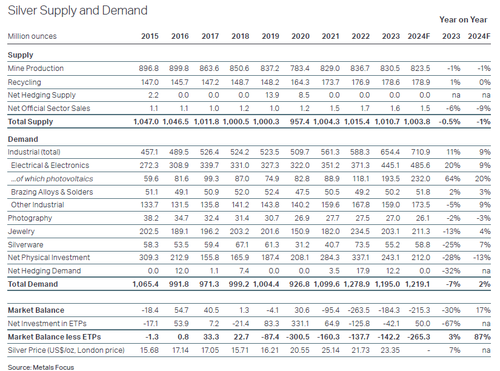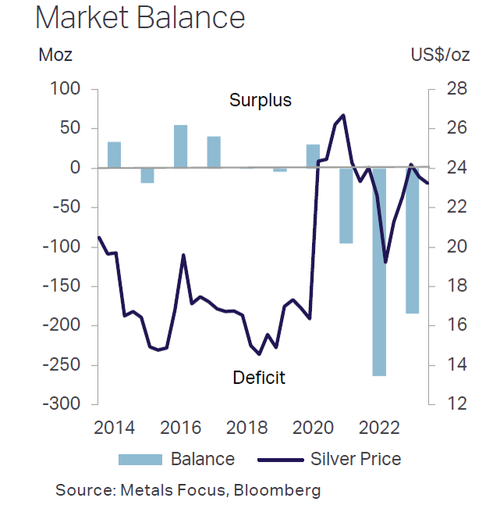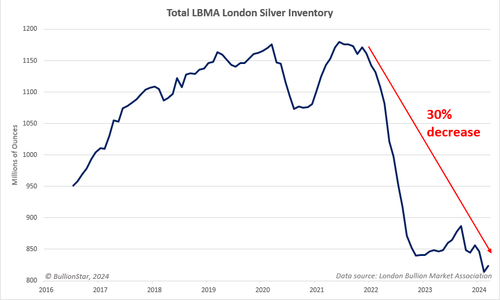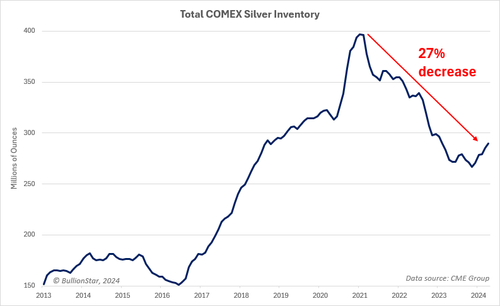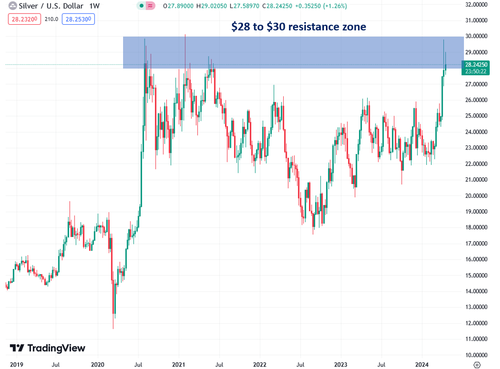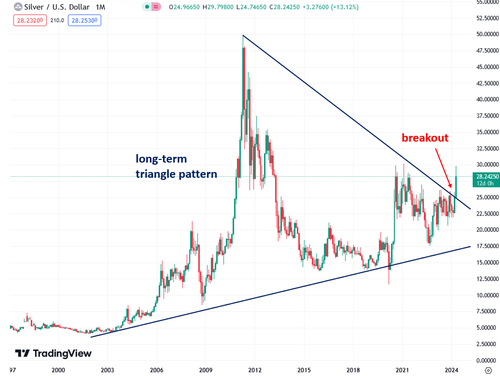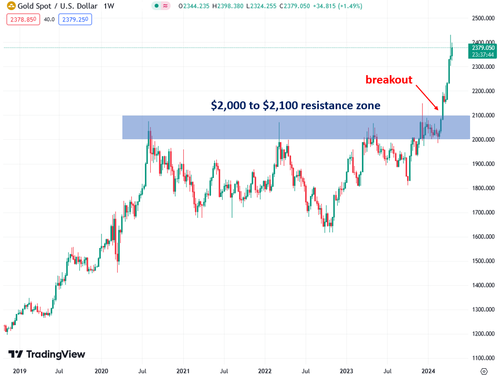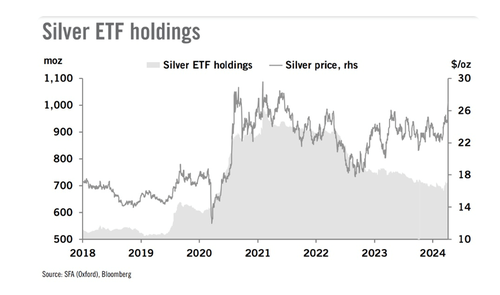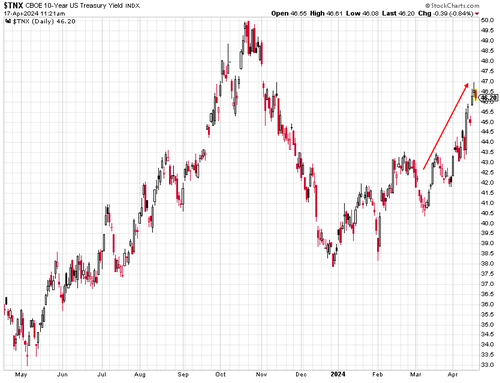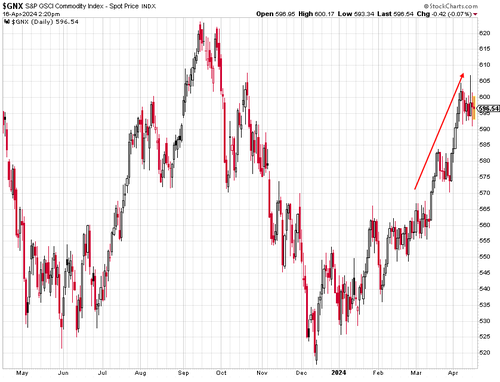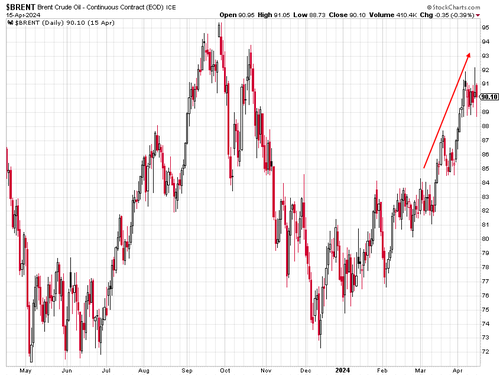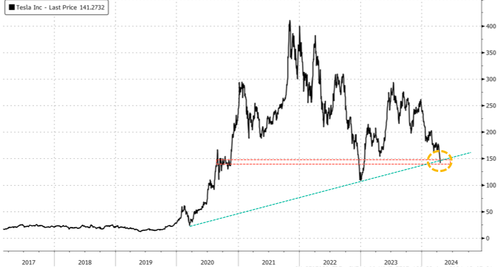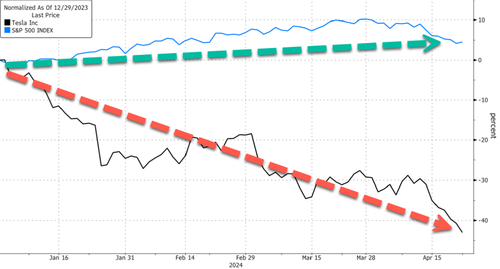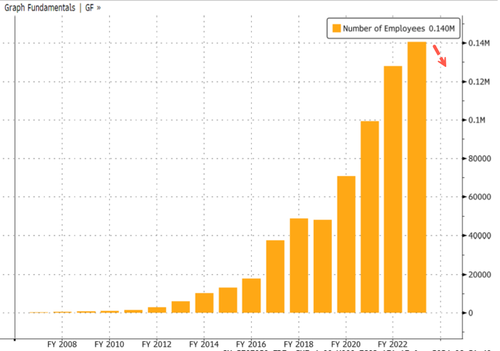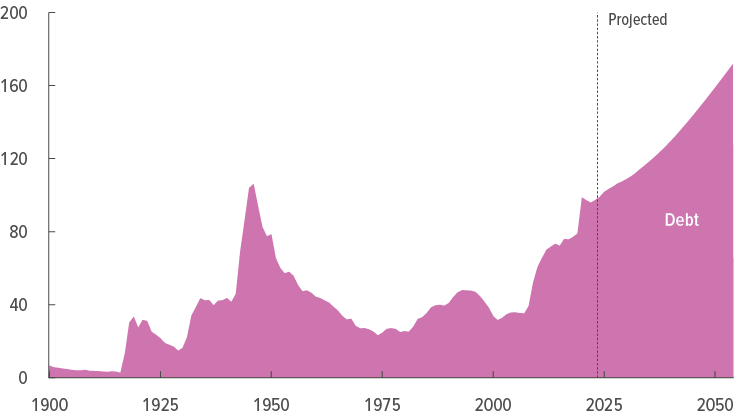“What is perfection in love? Love your enemies in such a way that you would desire to make them your brothers … For so did He love, Who hanging on the Cross, said ‘Father, forgive them, for they know not what they do.’” (Luke 23:34)
All
The Incentives Driving The Show For Silver, Copper & Corn …
These are the tactics that are driving the Western "markets" to eventual ruin. Is anybody in control? It seems not...
Trump Urges Supporters To "Peacefully Protest" As Day 1 'Opening Arguments' In Hush-Money Case Concludes Early
Trump Urges Supporters To "Peacefully Protest" As Day 1 'Opening Arguments' In Hush-Money Case Concludes Early
Tyler Durden
Mon, 04/22/2024 - 13:20
Day one of former President Donald Trump’s so-called “hush-money” trial concluded early on Monday after Judge Juan Merchan said that an alternate juror can visit a dentist appointment (despite previously telling Trump he would have attend every day without fail - missing his son's graduation - or face jail).
Judge Merchan had previously planned to adjourn the trial at 2 p.m. ET due to the Passover holiday. But he said Monday that it would adjourn at 12:30 p.m.
He previously said he would end at 2 p.m. on Tuesday for the holiday.
Jack Phillips reports, via The Epoch Times, that the early adjournment came after prosecutors and defense lawyers make their respective cases for why the former president should be convicted or acquitted. In the case, President Trump is accused of falsifying business payments during the 2016 campaign by allegedly paying a former lawyer, Michael Cohen, to bury negative stories.
At issue were claims from an adult film performer, Stormy Daniels, whose real name is Stephanie Clifford, that she was engaged in a relationship with the former president. President Trump has denied her claims and has pled not guilty.
‘Use Your Common Sense’
An attorney for the former president spoke to the jury, asking them to “use your common sense” when they assess the case.
“We’re New Yorkers. It’s why we’re here,” Todd Blanche said.
“There will be a very swift not guilty verdict” if they decide based on the evidence involved, he said.
“You told all of us, you told the court, you told me, you will put aside whatever views you have of President Trump,” Mr. Blanche told the jury as he wrapped up his arguments.
“The 34 counts, ladies and gentlemen, are really just pieces of paper,” Mr. Blanche said of the indictment. “None of this was a crime.”
Mr. Blanche was critical of Ms. Clifford, saying that she has earned income and fame from her allegations about an alleged affair that occurred in 2006.
“She also wrote a book. She was paid for a documentary,” Mr. Blanche says of Ms. Clifford, adding that courts have sided with President Trump’s legal disputes with Ms. Clifford.
As for Mr. Cohen, Mr. Blanche accused him of profiting off his criticism of President Trump.
“His entire financial livelihood depends on President Trump’s destruction,” he said of Mr. Cohen.
“You cannot make a serious decision about President Trump relying on the words of Michael Cohen.”
“He has a goal, an obsession with getting President Trump,” Mr. Blanche said of Mr. Cohen, who is expected to be a witness. “I submit to you that he cannot be trusted.”
But prosecutors claimed on April 22 that the case wasn’t just about the payments to Mr. Cohen. They argued that it constituted election fraud.
‘Orchestrated a Criminal Scheme’
Prosecutor Matthew Colangelo, in a bid to reframe the narrative, said that President Trump, Mr. Cohen, and former National Enquirer boss David Pecker “formed a conspiracy ... to influence the presidential election.”
“The defendant, Donald Trump, orchestrated a criminal scheme to corrupt the 2016 presidential election,” he alleged.
“Then he covered up that criminal conspiracy by lying in his New York business records over and over and over again.”
Calling it “election fraud,” he provided several instances when the three allegedly conspired to block negative press about President Trump from becoming public before the 2016 contest.
The plan was allegedly hatched at Trump Tower shortly after the then-presidential candidate had announced his candidacy in what Mr. Colangelo is referring to as the “Trump Tower conspiracy.”
During that meeting, prosecutors say, Mr. Pecker agreed to “help the defendant’s campaign by working as the eyes and the ears of the campaign.”
Mr. Colangelo, senior counsel to the district attorney, told jurors that although the payments to Mr. Cohen, then Trump’s personal lawyer, were labeled as legal fees pursuant to a retainer agreement, there was no retainer and there were no legal services.
“The defendant was paying him back for an illegal payment to Stormy Daniels on the eve of the election. The defendant falsified those business records because he wanted to conceal his and others’ criminal conduct,” he said.
'Peacefully Protest'
In a Truth Social post before he left for the courthouse on Monday morning, President Trump wrote that he wonders why pro-Palestinian demonstrators are allowed to “roam the Cities, scream, shout, sit, block traffic, enter buildings, not get permits, and basically do whatever they want” while pro-Trump backers are “rudely and systematically shut down and ushered off to far away ‘holding areas,’ essentially denying them their Constitutional Rights.”
“America Loving Protesters should be allowed to protest at the front steps of Courthouses, all over the Country,” the former president wrote on social media, making reference to demonstrators who have appeared in front of the Manhattan courthouse where his trial is being held.
Those protests are “allowed for those who are destroying our Country on the Radical Left, a two tiered system of justice,” he added. “Free Speech and Assembly has been ‘CHILLED’ for USA SUPPORTERS.”
Later, he urged his supporters to “GO OUT AND PEACEFULLY PROTEST. RALLY BEHIND MAGA. SAVE OUR COUNTRY!”
When entering the courthouse on Monday, President Trump again criticized the case during a brief interview with reporters.
“I’m here instead of being able to be in Pennsylvania and Georgia and lots of other places campaigning and it’s very unfair,” he said.
A small group of anti-Trump protesters was seen outside the courthouse ahead of opening statements, chanting, “No one is above the law,” while members of the media and public lined up to get inside, according to reporters on the scene. It’s unclear if any pro-Trump demonstrators heeded the former president’s call on social media.
Why A Powerful Silver Bull Market May Be Ahead
Why A Powerful Silver Bull Market May Be Ahead
 Sources of silver demand. Source: GFMS Definitive, Metals Focus, The Silver Institute, UBS
Sources of silver demand. Source: GFMS Definitive, Metals Focus, The Silver Institute, UBS
 2024 Iranian strikes in Israel. Mehr News Agency.
Tyler Durden
Mon, 04/22/2024 - 13:00
2024 Iranian strikes in Israel. Mehr News Agency.
Tyler Durden
Mon, 04/22/2024 - 13:00
By Jesse Colombo of BullionStar
Since early-March, precious metals have launched one of their sharpest rallies in decades. Gold surged by 16% and silver by 26%, which are significant moves for safe-haven assets — especially considering that it played out over such a short time period. During this rally, gold has received the lion’s share of the attention because it has been hitting all-time highs, while silver has yet to exceed its 2021 high of $30.13 — let alone its all-time high of $49.81 that was reached all the way back in 2011. Though silver has been languishing for the past several years, there are numerous reasons why it may be on the verge of one of its most powerful bull markets in history.
Silver Demand is Growing Rapidly
Though silver is most known for its use in jewelry, silverware, coinage, and bullion products, the largest source of silver demand is actually industrial in nature. Thanks to its unique physical, chemical, and electrical properties, silver is used in electronics, solar panels, automobiles, photography, medicine, the chemical industry, and much more.
 Sources of silver demand. Source: GFMS Definitive, Metals Focus, The Silver Institute, UBS
Sources of silver demand. Source: GFMS Definitive, Metals Focus, The Silver Institute, UBS
The growing number of uses for silver combined with ongoing global economic growth is causing a substantial increase in industrial demand for silver. According to the latest report from the Silver Institute, industrial demand for silver grew by a solid 11% to a record of 654.4 million ounces in 2023, which came on the heels of a record year in 2022. Silver used for photovoltaic (PV) applications skyrocketed by 64%, which caused electrical & electronics demand to increase by 20% in turn. As the push for so-called “green" energy continues, photovoltaic silver demand should keep growing at a rapid rate. The Silver Institute predicts a 9% increase in industrial demand for silver in 2024.
The steady increase of industrial demand over the past decade is driving overall silver demand higher:
There is a Structural Silver Deficit
Since 2021, there has been a deficit of silver due to demand exceeding supply — a condition that has helped to boost prices and should continue to do so for the foreseeable future. Strong demand combined with tepid supply increases led to a deficit of 184.3 million ounces in 2023 and are expected to lead to an even worse deficit of 215.3 million troy ounces in 2024.
The chart below shows how the silver deficit has grown significantly over the past few years:
While silver demand has grown at a healthy clip over the past four years, the overall supply of silver has been flat for more than a decade:
Global mine production of silver has actually been declining for the past decade:
(Read our recent report about the structural silver deficit and why it is likely to persist and even intensify.)
Above-Ground Supplies Are Dwindling
The silver deficit of the past few years is causing the above-ground supply of silver to dwindle at a rapid rate:
The total London Bullion Market Association (LBMA) silver inventory decreased by 30% from its peak in 2021:
The total COMEX silver inventory (a measure of U.S. silver inventories) fell by 27% since 2021:
The total silver inventory on China’s Shanghai Gold Exchange fell by an incredible 73%:
The total silver inventory on China’s other main silver trading venue, the Shanghai Futures Exchange (SHFE), also fell precipitously:
The Technical Picture
For the past year, silver had been chopping up and down aimlessly until its sudden surge that came practically out of nowhere:
A look at the five-year chart shows that there is a major resistance zone overhead from $28 to $30, which is what silver struggled to surpass during the last bull run in 2020 and 2021. If silver can close above that zone in a convincing manner with heavy volume, that would signal that another bull run is likely imminent.
The long-term silver chart going back to the year 2000 shows something very interesting: a triangle pattern has been forming for over a decade as uptrend lines and downtrend lines converge together. Patterns like this often result in very powerful moves when the asset finally breaks out from it. Amazingly, silver has recently broken out from its long-term triangle, which means that a powerful bull market is likely ahead that could take silver to its prior 2011 highs of approximately $50 and even higher after that!
Silver has been rising in sympathy with gold after it broke above its critical $2,000 to $2,100 resistance zone that acted as a price ceiling from 2020 until recently. Gold’s breakout signifies that a new bull market has begun, which should help bring silver along for the ride. (There are many parallels between gold’s resistance zone and silver’s current $28 to $30 resistance zone, and silver should really shine once it finally breaks through.)
Mainstream Investors & Journalists Missed Silver’s Rally
What is also worth noting is how gold and silver’s surprising recent rally has received very little mainstream attention by a press that is much more enamored with hot AI stocks as well as Bitcoin and other cryptocurrencies that have recently benefited from the U.S. government’s approval of a number of Bitcoin exchange-traded funds (ETFs), which has resulted in tremendous inflows from institutional investors and retail investors alike.
As the chart below shows, investors have pulled a significant amount of funds from silver ETFs in order to re-invest in Bitcoin ETFs, which is ironic considering its timing shortly before silver’s liftoff (and is confirmation of contrarian investing principles). The continuation of silver’s bull market will likely lead to funds flowing back into silver ETFs, providing additional fuel for the rally.
Silver is Inexpensive by Historical Standards
Precious metals analysts keep an eye on the gold-to-silver price ratio to get a sense of whether silver is undervalued or overvalued relative to gold. Silver is approximately 17.5 times more common than gold in earth’s crust, which is one of the reasons why silver has been cheaper than gold throughout history. During the Roman empire, the gold-to-silver price ratio was set at 12 to 1 by government decree. In much of Europe throughout the Middle Ages and the Renaissance, the gold-to-silver price ratio was set at similar levels. In 1792, the newly formed U.S. government set the ratio at 15:1.
When the gold-to-silver ratio differs greatly from its long-term historical average, there are reasons to believe that something is amiss and that the ratio will eventually revert back to its historical average. In recent decades, the gold-to-silver price ratio has ranged from approximately 50 to 100, which is much higher than its historical average.
The current gold-to-silver ratio is a lofty 84.3, which means that silver is extremely undervalued relative to gold based on historical standards. If the ratio were to revert to its average since 1915 of 52.8 (without any price increase in gold), that would result in silver being priced at a respectable $45 an ounce. If the ratio were to revert to 15:1, as it was in the U.S. in 1792, that would result in silver trading at $158.87 an ounce — an incredible 464% increase from the current price! For this reason, many investors expect silver to perform even better than gold during the coming precious metals bull market and revaluation that they expect to occur when our unsustainable global paper money system collapses (as I discussed in a recent piece). Any price increases in gold would amplify price increases in silver, if the gold-to-silver ratio reverts.
Adjusting silver’s price for inflation also shows that the precious metal is quite cheap by historical standards. At the peak of the Hunt brothers-induced silver spike in 1980, silver hit an inflation-adjusted price of $143.54. At the peak of the quantitative easing-driven bull market in 2011, silver hit an inflation-adjusted price of $67.50. At the time of writing, silver is trading at a mere $28.30, which means that it has much further to run if it is going to catch up with prior inflation-adjusted prices.
Another way to determine whether silver is undervalued or overvalued is to compare it to various money supply measures. The chart below shows the ratio of silver’s price to the United States M2 money supply, which is helpful for seeing if silver is keeping up with money supply growth, outpacing it, or lagging it. The M2 money supply is a measure of all notes and coins that are in circulation, checking accounts, travelers’ checks, savings deposits, time deposits under $100,000, and shares in retail money market mutual funds.
If silver’s price greatly outpaces money supply growth, there is a heightened chance of a strong correction. If silver’s price lags money supply growth, however, there is a good chance that silver will soon experience of period of strength. Since the mid-2010s, silver has slightly lagged M2 money supply growth, which could set it up for a period of strength due to the other factors discussed in this piece.
Silver is Rising Despite the Strong Dollar & Interest Rates
What is particularly impressive about the recent rally in silver and gold is the fact that it occurred even while the U.S. dollar was strengthening against other major currencies. Precious metals and the U.S. dollar have a long-established inverse relationship, which means that strength in the dollar typically causes weakness in precious metals, while dollar weakness typically causes precious metals prices to rise.
The chart below compares silver (the top chart) to the U.S. Dollar Index (the bottom chart) and shows how action in the dollar often causes an opposite trend in silver. Silver’s surge in the face of the strengthening dollar is a sign of strength and staying power. (I need to clarify, however, that the U.S. dollar’s exchange rate is strengthening against other fiat currencies; this does not mean that the dollar is getting stronger in terms of purchasing power or against sound money like gold and silver. All fiat currencies are being debased as a function
On a similar note, silver and gold are also rallying even though global interest rates have been rising at the same time due to inflation proving to be stubborn, and even at risk of increasing again. Rising interest rates are typically bearish for precious metals because they don’t pay any yield, but silver and gold appear to be unfazed this time, which is an additional sign of strength and staying power. of time but they still fluctuate against each other in the global foreign exchange market.)
How Inflation is Contributing to Silver’s Recent Rise
Another important factor driving the recent precious metals rally is stubbornly high inflation that is not easing as quickly as economists and investors had expected and may actually be worsening instead. Gold and silver are inflation hedges and are very sensitive to changing inflation expectations. U.S. year-over-year inflation — as measured by Consumer Price Index (CPI) — increased at a 3.5% rate in March, which immediately caused traders to scale back their expectations for Federal Funds Rate cuts this year. March’s inflation rate represents an acceleration from February’s 3.2% increase.
The sharp increase in commodities prices over the past few months is further confirmation that inflation may be accelerating:
Crude oil has rallied over the past few weeks:
U.S. wholesale gasoline prices have increased by an alarming 30% in the past two months and are one of the most psychologically important and visible indicators of inflation in the minds of consumers:
China’s Economic Crisis is Helping Precious Metals
Though most non-Chinese are unaware, China is experiencing a serious economic crisis as well as a property and stock market crash after at least two decades of almost non-stop boom times. Unfortunately, that economic boom was actually an unsustainable bubble that was enabled by
and reckless speculation, and the chickens are now coming home to roost. China’s imploding property and stock market bubbles have resulted in at least hundreds of billions of dollars worth of losses — including
alone from the country’s property tycoons.
As Chinese investors lost faith in the property and stock market, they have shifted their attention to gold, which has earned a stellar reputation in China over thousands of years. When modern financial markets and investments sour, Chinese people seek refuge in gold bullion, which is tried-and-true. Chinese investors have clamored into the gold market with such intensity that they have pushed the price of locally-traded gold to a premium against the international price of gold.
In addition, Chinese investors recently piled into a domestic gold stock fund causing its premium to surge 30% until trading was halted to calm the frenzy and protect investors. Around the same time, the Shanghai Gold Exchange raised silver margin requirement from 10% to 12% after silver futures spiked. Though everyday Chinese investors tend to focus more on gold rather than silver, their heavy buying has helped to buoy the price of gold, which has boosted silver in turn. China’s massive economic bubble formed over decades and its collapse is only in the early stages — a fact that should propel precious metals prices higher for years to come.
Precious Metals Are Benefiting From Political Uncertainty
On top of their roles as inflation hedges, gold and silver are also hedges against economic and political uncertainty, and there is a great amount of political uncertainty this year as more than 60 countries — including the United States, Mexico, India and Indonesia — are set to hold national elections. In the United States, President Joe Biden and former President Donald Trump are expected to go head-to-head again as they did in 2020.
Economic issues, including inflation, have soared to the top of the list of concerns for Americans who are growing increasingly frustrated with so-called “Bidenomics" as the cost of living continues to rise at an uncomfortable pace while middle class life becomes further out of reach for a large portion of the population. The Biden administration’s heavy spending and willingness to rack up the national debt have exacerbated the country’s inflation problem, which is why it is catching flak from Americans on both sides of the aisle. In theory, a Biden win should prove beneficial for precious metals prices.
Geopolitical Risks Are Helping Gold & Silver
In addition to the other factors mentioned so far, precious metals are also benefiting from mounting geopolitical risks related to the Israel-Hamas war and the Russia-Ukraine war. The Israel-Hamas war has now been going on for six months and is heating up, unfortunately. On April 13th 2024, Iran fired hundreds of drones, cruise missiles, and ballistic missiles at Israel, which is Iran’s first direct attack on Israel since the conflict started and the first ever attack on Israel directly from Iranian soil (in the past, Iranian proxies were used to attack Israel). Though 99% of Iran’s drones and missiles were intercepted by Israel’s sophisticated Iron Dome air defense system, the attack sent a powerful message and represents a new phase of the war that is playing out across the Middle East.
The April 13th attack was retaliation after Israel struck numerous Iran-backed targets in Syria. Israel now vows to retaliate against Iran for its April 13th attack, which would further perpetuate the tit for tat cycle. As geopolitical analyst Max Abrahms said, “Iran and Israel are now at war. A real, direct war." Economist and best-selling author James Rickards is now warning about the rising risk of a nuclear war and saying that gold’s rally “is just getting started" due to that risk.
 2024 Iranian strikes in Israel. Mehr News Agency.
2024 Iranian strikes in Israel. Mehr News Agency.
The Russia-Ukraine war has also taken a turn for the worse recently after Russia shot down 53 Ukrainian drones and the Kremlin warned that Russia and NATO are now in “direct confrontation.” Ukraine took credit for destroying at least six Russian fighter jets, damaging eight more, and killing or injuring 20 service personnel. The BBC has estimated that over 50,000 Russian military personnel have been killed so far in the war against Ukraine, while Ukrainian President Volodymyr Zelensky claimed that 31,000 Ukrainian military personnel have been killed — a figure that is likely understated.
The Potential For a #SilverSqueeze
In early-2021, investors and traders affiliated with the r/WallStreetBets (WSB) subreddit began promoting a theory, movement, and hashtag called #SilverSqueeze with the intention of piling into physical silver en masse in order to create a short squeeze that forces big banks and other institutions to buy back their short positions (i.e., bets against the price of silver) that are used to suppress the price of silver. If successfully pulled off, the theory went, the price of silver would skyrocket to all-time highs, which would simultaneously generate significant profits for #SilverSqueeze participants while punishing the institutions that were suppressing the price of silver.
In 2021, BullionStar agreed with and supported the #SilverSqueeze movement and still does — even though it may have been ahead of its time. We still believe that a #SilverSqueeze is likely to occur in the not-too-distant future when the manipulating institutions finally lose control of the physical silver market. We have also written extensively (here, here and here) about the manipulation and suppression of the physical gold and silver markets.
The proliferation of “paper" silver products (ETFs, futures, and other derivatives) dwarfs the supply of actual physical silver by a multiple of at least 100 to 1. The sheer volume of outstanding paper silver has had the effect of absorbing demand that would normally have flowed into and benefited the physical silver market. Furthermore, the glut of ersatz silver has suppressed the price of physical silver and has prevented true and fair price discovery.
In the coming #SilverSqueeze, we believe that investors will be forced to reckon with the fact that there is just a fraction of the physical silver in existence that they believed, which will lead to a scramble for physical silver while paper silver products sink in value. Silver’s recent breakout, if it can be sustained, has a strong potential of evolving into a #SilverSqueeze as the bull market gains momentum.
Tesla Shares Slide As Price-Cuts In US, China, & Germany Spark Worsening EV Price-War
Tesla Shares Slide As Price-Cuts In US, China, & Germany Spark Worsening EV Price-War
 Source: @Tslachan
Tyler Durden
Mon, 04/22/2024 - 12:40
Source: @Tslachan
Tyler Durden
Mon, 04/22/2024 - 12:40
Tesla shares tumbled nearly 6% on Monday morning, on pace for the seventh straight down session, as the EV-maker once again slashed vehicle prices across major markets—China, Germany, and the US—amid the worsening EV price war.
In China, Tesla dropped Model 3, Y, S, and X vehicle prices by 14,000 yuan, or $1,933, according to Bloomberg. US prices for Model Y, S, and X vehicles were reduced by $2,000. The Model 3 saw no reduction in price in the US.
A base-level Model Y in China now starts at around 250,000 Yuan, or $35,000. In the US, base models of Tesla Y, S, and X begin at $43,000, $73,000, and $78,000, respectively.
Following the price cuts, Evercore's Chris McNally told clients that Tesla's China business "may now be breakeven or even negative" based on earnings before interest and taxes. This isn't good for the company operating in the world's largest EV market.
The continued and worsening EV price war led Chinese electric vehicle manufacturer Li Auto to cut prices by 6% to 7% across its vehicle lineup. The L7 sport utility vehicle now starts at around 301,800 yuan.
On Sunday, Musk wrote on X, "Tesla prices must change frequently in order to match production with demand."
Other cars change prices constantly and often by wide margins via dealer markups and manufacturer/dealer incentives. Only a fool thinks the “MSRP” is the real price.
Tesla prices must change frequently in order to match production with demand.
Wall Street soured on the latest round of price cuts, with shares down a little more than 4% around lunchtime.
"The volatility of prices has, however, impacted the appetite of professional buyers such as leasing and rental companies – Sixt and Hertz have elected to reduce their Tesla fleets due, in part, to uncertain used pricing," HSBC analyst Pushkar Tendolkar told clients.
The stock has plunged 43% this year, making it one of the worst performers in the S&P500.
Last week, The Wall Street Journal reported that Tesla was preparing to cut 10% of its global workforce, approximately 14,000 employees. Then, on Monday, Bloomberg reported that the company's newly formed marketing team was laid off.
Tesla also slashed the price of its Full Self-Driving software from $12,000 to $8,000 in the US. This followed the most recent halving of the FSD subscription from $200 to $100 per month.
 Source: @Tslachan
Source: @Tslachan
On Tuesday, Tesla is expected to report first-quarter earnings. LSEG data shows that the world's most valuable automaker is likely to post its first revenue drop and lowest gross margin in nearly four years. This comes after the company reported a slide in vehicle deliveries for the first quarter earlier this month.
North Korea evades sanctions even in cartoons (thanks to Beijing)
According to an investigation by 38 North, which monitored a North Korean cloud server in January 2024, North Korean workers appear to have worked on animation projects by Amazon and HBO Max studios after the latter subcontracted some of the work to Chinese firms, which did the same with North Korean firms.
Kick Back, Watch It Crumble
Kick Back, Watch It Crumble
Tyler Durden
Mon, 04/22/2024 - 12:25
Submitted by QTR's Fringe Finance
The title to this post comes from one of my favorite NOFX songs, Dinosaurs Will Die.
While I’m sure the band in absolutely no way agrees with most, if not all, of my political leanings, the critiques they raise about the music industry in the song could serve just as well as many of the questions I want to ask of legacy mainstream media and politicians from both sides of the aisle in our government.
Leading those questions, for me, is this one: Doesn’t it elicit a hopeless feeling sometimes that we always have to learn the hard way in this country?
Few things are surer than taxes and death, but one of them is that our powers that be will make up any excuses necessary, scapegoat anything possible, and generally exercise every single possible wrong decision before reluctantly realizing that a consequential, uncomfortable yet important, proactive adult decision needs to be made and/or communicated to the American public.
Nobody ever wants to fess up to doing something wrong and nobody has a tolerance for even an ounce of discomfort, even when it accompanies an obvious decision that is in the best interest of our nation.
There have been too many examples in recent memory to name, but one of the latest bouts of us acting like a scared 6 year old with an aversion to reality was the farce of the Fed and Biden administration constantly telling the nation that inflation was transitory, when that has turned out to be the polar opposite of the truth.
Janet Yellen, unable to ascertain a clue in the real world, looking for one in the virtual world.
Zooming out from the inflation farce, monetary policy in general is another example of our inability to digest even subatomic amounts of bad news. We would rather pile on larger and larger tranches of quantitative easing, flying blind and ignorant of the potential consequences of our novel virus of a monetary policy experiment, than deal with the reality—or even the thought—of a recession.
Captain O’Connell said it best in Armed and Dangerous:
“The world is a sh*thole, full of sh*tty little scumbags, who are scared sh*tless.”
Yes, we have chickenshit cowards, whose fragility won’t physically allow their bodies to utter the truth, on both sides of the political aisle. It is a toxic brew of being spineless and an incessant need to be reelected.
Donald Trump lied to us over and over about Covid, saying we had 15 cases that were going to zero. Ben Bernanke told us that subprime housing was contained in the very moments leading up to the 2008 financial crisis. Joe Biden is blaming today’s inflation, very obviously the result of the massive money printing that took place during Covid, on Vladimir Putin, Donald Trump, corporate greed and pretty much any person or inanimate object his feeble brain can conceptualize. Elected leaders support violent protests until they show up on their front lawn. They have no problem telling us that we need to stay home and isolate while they go out to expensive dinners and make trips to the salon. One presidential candidate rails on the other for corruption while engaging in the very same practices they decry.
Out of the hundreds of representatives in Congress, I could probably count the people of integrity from both sides of the aisle using one hand — to say we have lost our way would be a vast understatement. While I thought Bob Moriarty did a great job outlining the end of the empire on my last podcast with him, this weekend provided us an even clearer example of just how profoundly lost we have become.
It’s already bad enough that the nation is in such a precarious debt-to-GDP situation that more than 90% of countries in history that have followed the same fiscal path have wound up defaulting. And it’s similarly disturbing that, despite these obvious realities and the Federal Reserve being stuck between a rock and a hard place, we have thrown our hands up in the air and decided to YOLO the economy by spending as much as humanly possible before the inevitable default.
Honestly, I’m not trying to be hyperbolic, but monetarily and fiscally there seems to be no other way to describe our government’s actions other than willingly and excitedly driving the country full speed ahead towards the death of the dollar.
As if this situation wasn’t insulting enough, over the weekend the United States House of Representatives approved more foreign aid, totaling nearly $100 billion and including $60 billion to Ukraine, without similarly funding to secure our own nation’s southern border.
Putting aside the very real argument that we simply don’t have the money to spend—I’ve given up on trying to reason with anybody about that argument — how could we then still put foreign nations' security above our own? This weekend was a glaring example of how truly futile an exercise it is to hope for reason and common sense in Congress.
Passing this foreign aid not only shows that our leaders can’t “read the room”, it goes to show they simply don’t know the difference between being nice to other nations versus extending so much help that it becomes counterintuitive to our own country. Not only that, prioritizing the security of other nations over our own is, at its core, a slap in the face to U.S. taxpayers on both sides of the aisle. And after the bill passed overwhelmingly in the House this weekend, representatives tarred and feathered those still-red-from-being-slapped faces by waving Ukrainian flags on the House floor.
Look, playing Devil’s advocate, I know what politicians are thinking (if you can call it that): we are in the midst of defending democracy and Western values by supporting Ukraine and Israel.
They are thinking we have always had an excess of room to spend, and it has never led to meaningful consequences for the country, so why not shovel another $100 billion of taxpayer cash that will be spent without an audit overseas?
They’re thinking the border crisis will be an election issue and that both sides will secretly be happy that an agreement hasn’t been reached so that it can play out as a key issue leading up to November. In addition to thinking these things, they’re thinking generally that they are doing the right thing.
It’s the same type of naïve logic that people reason to themselves when helping out a friend or family member who is an addict. They continue to lend them the 20 bucks a day that they ask for, hoping that eventually they will find a long-term solution to their addiction while staving off short-term withdrawals by buying more drugs, booze or lottery tickets.
They do it so the person stops asking for the day and many times they do it because they think it’s the right thing to do. And, as is almost always the case, it isn’t, and the “helper”, who has actually become an “enabler”, winds up as one of the key figures in an intervention where they have to eventually threaten to withhold all of the “help” they’ve been giving and try to put the addict to a decision to break out of the devastating grip of the addiction pattern they’re in.
I’m not trying to liken Ukraine or Israel to addicts—I can see the benefit to helping both nations and certainly I can see the benefit of trying to defend Western values on a global scale. But it’s when it comes at the expense of our nation that it becomes the wrong decision. And right now, we simply don’t have the resources to offer help and—most alarmingly—we are a nation that needs to help itself first.
I don’t know what it’s going to take for us to reach the point where we realize we need an intervention, but sadly our history of cowardice approaching uncomfortable problems and making tough decisions leads me to believe it’ll come only at a point after it is far too late.
Looking back from that point, it’ll be so obvious how we failed to do the right thing for our country at these crucial moments. We will deal with the consequences then because we will be forced to. Eventually, no matter how catastrophic the issue, we will figure out a path to rebuild—not unlike other nations and empires that have fallen or defaulted—and we will carry on. This I’ve come to accept.
But don’t be surprised if the shame and humiliation of slapping the US taxpayer in the face like we’ve done this weekend isn’t quite as easy to process, get over and rebuild from.
My only hope is that our misguided decision-making at some point serves as a learning experience for future generations. But for us now, sadly, the die has already been cast, and my prediction is the coming years and decades will be bumpy ones.
QTR’s Disclaimer: I am an idiot and often get things wrong and lose money. I may own or transact in any names mentioned in this piece at any time without warning. Contributor posts and aggregated posts have not been fact checked and are the opinions of their authors. They are either submitted to QTR, reprinted under a Creative Commons license or with the permission of the author. This is not a recommendation to buy or sell any stocks or securities, just my opinions. I often lose money on positions I trade/invest in. I may add any name mentioned in this article and sell any name mentioned in this piece at any time, without further warning. None of this is a solicitation to buy or sell securities. These positions can change immediately as soon as I publish this, with or without notice. You are on your own. Do not make decisions based on my blog. I exist on the fringe. The publisher does not guarantee the accuracy or completeness of the information provided in this page. These are not the opinions of any of my employers, partners, or associates. I did my best to be honest about my disclosures but can’t guarantee I am right; I write these posts after a couple beers sometimes. Also, I just straight up get shit wrong a lot. I mention it twice because it’s that important.
Israel's Military Intelligence Chief Resigns Over Oct.7 Failures
Israel's Military Intelligence Chief Resigns Over Oct.7 Failures
 Maj. Gen. Aharon Haliva, chief of IDF Military Intelligence Directorate
Tyler Durden
Mon, 04/22/2024 - 12:05
Maj. Gen. Aharon Haliva, chief of IDF Military Intelligence Directorate
Tyler Durden
Mon, 04/22/2024 - 12:05
Israel’s top military intelligence official has announced his resignation in a shock development for the country while it's still at war, citing his failure to anticipate the Oct.7 Hamas terror attack. Maj. Gen. Aharon Haliva, chief of the Israel Defense Forces Military Intelligence Directorate, is expected to vacate the position as soon as his replacement is appointed.
This makes Haliva the first senior officer to resign over Oct.7, and comes as large Israeli protests have persisted in reaction to the Netanyahu government's failure to achieve the safe return of the remaining hostages being held by Hamas.
 Maj. Gen. Aharon Haliva, chief of IDF Military Intelligence Directorate
Maj. Gen. Aharon Haliva, chief of IDF Military Intelligence Directorate
A military announcement confirmed the resignation has been approved by Defense Minister Yoav Gallant. According to a statement in Israeli media, "Alongside Haliva, other top defense officials have said they bear responsibility for the deadly invasion carried out by Hamas on October 7, including the head of the Shin Bet security agency and the IDF chief of staff."
As for these additional officials, "None of them has announced plans to resign as of yet, though many are expected to do so once the security situation stabilizes," Times of Israel reports.
There's been widespread questioning as to how Hamas and other Palestinian militants were able to breach Israel's southern borders with ease on Oct.7 - even overrunning IDF border outposts, amid the deadly attack on the Nova music festival. Israel has some of the most sophisticated and advance surveillance systems in the world.
Over 1,160 people were killed, mostly civilians, and more than 240 Israelis and foreigners were taken hostage, but many of the captives have since died. The security failures of Oct.7 are still under investigation and are likely to be scrutinized for years to come.
But Al Jazeera observes that Gen. Haliva's resignation from the top military intelligence post is also political and relates to PM Netanyahu's handling of the crisis and ongoing war in Gaza:
Akiva Eldar, an Israeli author and former columnist with Haaretz newspaper, says Major-General Halavi quit likely because Netanyahu isn’t going to end the war on Gaza anytime soon.
Eldar added another reason is that the prime minister “is not interested in bringing the captives back to Israel”.
“Netanyahu is the highest authority and he never took responsibility [for the Hamas attack] so Haliva wanted to send a personal message to tell him, ‘If I can do it, you can do it,’” he said.
As for the Israeli military's own internal investigation into Oct.7 security and intel failures, it is expected to look the way back to 2018 in terms of scope.
The following areas will focus of a deep investigation: "The main subjects being investigated by the General Staff are: the development of the IDF’s perception of Gaza, with an emphasis on the border, starting in 2018; the IDF’s intelligence assessments of Hamas from 2018 until the outbreak of the war; the intelligence and decision-making process on the eve of October 7, as well as the days leading up to it; and the command and control, formations, and orders given during battles between October 7 and 10, when troops restored control over all communities and army bases in southern Israel that had been invaded by Hamas," according to Times of Israel.
Doctor comments on the Illinois assisted suicide proposal.
The following Letter to the Editor was published on April 20, 2024 by The News Gazette.
While I agree with common concerns like abuse, misdiagnosis, medication issues and lack of safeguards, I want to focus on another aspect, especially from an emergency physician’s standpoint.
With over three decades of practicing emergency medicine, I have encountered numerous patients at the end of their lives. In emergency medicine, our aim is to cure whenever possible, but above all, to provide care. Sometimes, this entails accompanying patients and their loved ones on their journey towards the inevitable end of life.
Reflecting on physician-assisted suicide, it is impossible to ignore that facilitating a patient’s death contradicts the fundamental principles of medical care, upheld from antiquity to modern medical science. It is disconcerting to see physicians suggesting or providing a direct pathway to end a patient’s life, thus neglecting their duty of care, even towards those with terminal conditions.
Physicians advocating for physician-assisted suicide lack coherence in their justifications, citing reasons such as “dying with dignity” or alleviating suffering by ending life.
Instead of delving into comprehensive approaches to pain management, addressing social support deficiencies, or exploring the psychological, spiritual and emotional aspects of patients’ suffering, they advocate for the ultimate shortcut — facilitating death as the solution.
Redirecting resources from initiatives for physician-assisted suicide toward research for better end-of-life care, enhancing mental-health resources and optimizing pain management would better serve patients and society.
We must reconsider this tragic deviation from our responsibility as healers and stewards of health care.
Dr. GREGORY TUDOR
Peoria
Bishop Barron and D.C. Schindler on ‘Integralism’
Last week, Bishop Robert Barron interviewed D.C. Schindler and integralism was among their topics of conversation. Their discussion of our approach to Catholic political philosophy was revealing in two important ways.
First of all, their interview revealed how much these two formidable thinkers have misunderstood the very terms of the debate. Bishop Barron introduced the topic by noting some might think Schindler “sounds like an integralist,” like someone who “just wants to create one great theocratic society.” These two things are not the same; integralism does not imply theocracy, or the rule of secular society by clerics. While the Vatican City State exists as a theocracy, as did the Papal States when they existed, the hope of the integralist is not to extend such rule throughout the world. In 2024 it should be clearer than it is to some that theocracy is not the only illiberal option for structuring society. Andrew Willard Jones’s Before Church and State, for instance, helps to expand our vision to see that a strict separation of Church and State on the one hand and theocracy on the other are not our only options. The France of Saint Louis which it depicts is an integralist society, not a theocratic one.
Dr. Schindler tries to find a via media between liberalism and integralism. With the integralist, he recognizes that the Church has an authority and a voice in politics and in the structuring of secular society, which liberalism denies. He admits overlap with integralist thinking but finds in it a fundamental problem. Schindler’s version of integralism is one in which the secular society provides “partial human goods,” to be supplemented by the Church’s provision of supernatural goods. He rejects this because as he sees it, spiritual goods are essentially human goods. They are not superadded to the goods which secular society aims to provide.
At the heart of Schindler’s objection seems to be his view of the interaction between nature and grace, a view he shares with Henri de Lubac and other 20th-century theologians. Dr. Schindler believes that we humans have even on the natural level a desire for the supernatural, a desire for what only grace provides. This subsumes the realm of the natural into that of the supernatural, and so for Schindler it does not make sense when the integralist distinguishes these two realms in terms of different ends. For him, there is only one end of human life, which is our union with God in glory.
The integralist follows the teaching of Pope Leo XIII on the natural and supernatural societies in Immortale Dei. As the document makes clear, both the society of the Church and the society of the State are given us by God Himself, both are necessary. Leo also teaches that both of these societies are perfect, that is to say, each of them possesses its proper end together with all the means necessary to reach that end. One cannot be subsumed by the other. The Holy Father wrote of the Church:
This society is made up of men, just as civil society is, and yet is supernatural and spiritual, on account of the end for which it was founded, and of the means by which it aims at attaining that end. Hence, it is distinguished and differs from civil society, and, what is of highest moment, it is a society chartered as of right divine, perfect in its nature and in its title, to possess in itself and by itself, through the will and loving kindness of its Founder, all needful provision for its maintenance and action. And just as the end at which the Church aims is by far the noblest of ends, so is its authority the most exalted of all authority, nor can it be looked upon as inferior to the civil power, or in any manner dependent upon it.1
Each of these societies, Church and State, has its proper end and all the means necessary to achieve it, the supernatural society of the Church having a supernatural end, the natural society of the State a natural one. For this reason, neither society can be seen to be ordered to merely a partial human good or any set thereof. Each is ordered to human happiness, which is the complete human good. But there exists a twofold end of happiness for man, who exists as it were in two realms, natural and supernatural, to which these societies correspond.
While our supernatural end is our ultimate end, toward which our temporal end must therefore be ordered, the two cannot be collapsed into one another:
The Almighty, therefore, has given the charge of the human race to two powers, the ecclesiastical and the civil, the one being set over divine, and the other over human, things. Each in its kind is supreme, each has fixed limits within which it is contained, limits which are defined by the nature and special object of the province of each, so that there is, we may say, an orbit traced out within which the action of each is brought into play by its own native right.2
The State “has for its proximate and chief object the well-being of this mortal life,” the Church “the everlasting joys of heaven.”3 This “is the Christian organization of civil society…confirmed by natural reason itself.”4 There ought to exist between these two societies not identity, but harmony:
The Church no less than the State itself is a society perfect in its own nature and its own right, and that those who exercise sovereignty ought not so to act as to compel the Church to become subservient or subject to them, or to hamper her liberty in the management of her own affairs, or to despoil her in any way of the other privileges conferred upon her by Jesus Christ. In matters, however, of mixed jurisdiction, it is in the highest degree consonant to nature, as also to the designs of God, that so far from one of the powers separating itself from the other, or still less coming into conflict with it, complete harmony, such as is suited to the end for which each power exists, should be preserved between them.5
This harmony brings the two necessary societies into quite close cooperation with one another, so close in fact that Leo XIII speaks of their relationship as that of the soul to the body. Not in such a way that one is subsumed by the other, but that both are fully active in their own realms.
Rather than by inventing sets of human goods, we have always defined integralism in terms of the ends of human life and the perfect societies which are necessary in achieving those ends. We have had such a clear definition of integralism for many years in the Three Sentences:
Catholic Integralism is a tradition of thought that, rejecting the liberal separation of politics from concern with the end of human life, holds that political rule must order man to his final goal. Since, however, man has both a temporal and an eternal end, integralism holds that there are two powers that rule him: a temporal power and a spiritual power. And since man’s temporal end is subordinated to his eternal end, the temporal power must be subordinated to the spiritual power.
This subordination is not one of domination (and therefore theocracy). It is one of cooperation. It is one in which ideally the membership of a secular society and the membership of the Church in that society are coextensive. In such a circumstance, as we see in St. Louis’s France, while the civil leaders have their requisite autonomy, they are nonetheless subject to the munera docendi, regendi, and sanctificandi exercised by the ecclesiastical hierarchy. The relationship is not one in which the clergy dictate to the civil leaders, but one in which the clergy help to inform them, as the soul in-forms the body.
Dr. Schindler wants the Church to “allow the integrity of the political sphere” rather than dictating to it. The Church, he says, has no place in making laws for the society of the State, but helps to inform what law ought to be in the secular realm. We do not disagree in the least. The relationship of the ecclesiastical to the secular does not have to be one of power and domination, which again brings us into theocratic territory. Yet the Magisterium and the Code of Canon Law are often quite clear in indicating what the civil law must provide, without dictating it.6 They elaborate the requirements of justice and the rights of Christians, and what the State must legislate in order not to run afoul of such requirements.
Integralism is political Catholicism, it is the faith lived out in the world. Our definition of integralism is purposely broad. As long as one gets right the relationship of the two ends of these two necessary societies, one is an integralist, which is to say, one has the only possible Catholic position.7 But below this level of general principle, integralism may work itself out in practice in an infinite number of ways, because of the infinite variety of practical circumstances.
There is no science of the infinite.8 It has always been our aim to define the principles, and to let Catholics figure out the practical applications of those principles, much as the Church always does in her social teaching. We may differ on our conclusions at the practical level, but two Catholics in good faith and in good conscience can always differ about such prudential matters. To my mind, if you accept the Three Sentences, you have a place beneath the integralist umbrella.
It is a wonderful thing that we have many Catholics working to bring about a post-liberal society, an integrally Catholic one. But the theory of any one integralist cannot be equated with integralism as a whole, any more than a particular economic theory espoused by a Catholic could be equated with Catholic economics.
Second of all, the interview between Bishop Barron and D.C. Schindler reveals the enduring importance of integralism. As His Excellency himself put it, Catholic integralism is “a rising movement today.” That to so many Catholics, liberal and illiberal alike, integralism continues to be such a bête noire, and that so many need to justify their own positions in contraposition to ours (or some imagined version of it), shows that integralism remains a touchstone in this conversation. We thank His Excellency and Dr. Schindler for giving us a place at their table, but ask that they let us speak for ourselves.
- Leo XIII, Immortale Dei, 10.
 ︎
︎ - Ibid., 13.
 ︎
︎ - Ibid., 14.
 ︎
︎ - Ibid., 16.
 ︎
︎ - Ibid., 35.
 ︎
︎ - Take, for example, c. 793 §2 on the State’s duty to help parents provide a true, integrally Catholic education for their children: “Parentibus ius est etiam iis fruendi auxiliis a societate civili praestandis, quibus in catholica educatione filiorum procuranda indigeant.”
 ︎
︎ - Cf. John Joy, “The Teaching of Quanta cura is Definitive: A Reply to Robert T. Miller.”
 ︎
︎ - Cf. Boethius, De arithmetica, Book I, ch. 1.
 ︎
︎
"Reality Check" - JP Morgan Warns Of Delay To Global Energy Transition
"Reality Check" - JP Morgan Warns Of Delay To Global Energy Transition
Tyler Durden
Mon, 04/22/2024 - 11:45
Authored by Irina Slav via OilPrice.com,
Inflation, interest rates, and wars may well delay the energy transition by quite a long time, JP Morgan has warned in a call for “a reality check” on its shift from hydrocarbons to alternatives.
“While the target to net zero is still some time away, we have to face up to the reality that the variables have changed,” the bank’s head of global energy strategy, Christyan Malek, told the Financial Times.
Malek was the lead author of a new report by JP Morgan focusing on energy.
The report noted higher interest rates, inflation, and the wars in Ukraine and the Middle East were all factors acting as setbacks for the transition.
The report—and Malek’s FT interview—coincided with another report, by Reuters, quoting Rystad Energy analysts as warning about the negative effects of higher interest rates on wind and solar energy developers.
"Owing to the capital-intensive (Capex) nature of renewable energy...they are inherently more susceptible to high-interest rates," Rystad Energy’s head of renewables and power, Vegard Wiik Vollset, said.
Wood Mackenzie has also warned that higher rates are having a negative effect on the economics of wind and solar, as a 2% rate increase can push the levelized cost of electricity for these two sources as much as 20% higher.
“Interest rates are much higher,” JP Morgan’s Malek also said, speaking to the Financial Times.
“Government debt is significantly greater and the geopolitical landscape is structurally different. The $3tn to $4tn it will cost each year come in a different macro environment.”
Because of these challenges, Malek forecasts that governments will dial down the push to transition from oil and gas to wind and solar as their financial resources dwindle.
The FT noted as an example the Scottish parliament’s recent decision to abandon a 75% emission reduction target by 2030 admitting it could not be achieved.
Senator Blakespear removed assisted suicide expansion bill.
The following article was published by Choice is an Illusion.
 California Senate Chamber
California Senate ChamberSenator Catherine Blakespear has removed proposed Senate Bill 1196, seeking to expand assisted suicide and euthanasia in California, from consideration prior to its first hearing Blakespear said in a statement.
"At this point, there is a reluctance from many around me to take up this discussion, and the future is unclear,”
“The topic, however, remains of great interest to me and to those who have supported this bill thus far.”
Senator Susan Eggman, who authored the original act in 2016, commented that pushing forward now would would create a risk of pushback. She stated:
With just a few weeks left to pass bills through policy committees before the Legislature's summer recess, it's unlikely another lawmaker would propos[e] a similar measure this year.
Senate Bill 1196 shows us the direction of the American euthanasia lobby. The Bill was only withdrawn because, as Senator Eggman stated it was "pushing for too much too soon."
Article: Good news: California assisted suicide expansion bill is dead. (Link)
Me-Me-Me-Meghan Is Toast, Or: Jam Wars, The English Way
Today I would like to make a little pause to tell you something that put a smile on my face and told me that the Country I live in still has a lot of people with a very British, pleasantly wicked sense of humour. The Narcissist Extraordinaire, Self-appointed Head Princess Feminist, Meghan ” I am […]
HE WHO HESITATES IS LOST
For Israel, Forbearance Could Be Fatal
By: Richard A. Epstein
Hoover Institution – defining ideas
April 16, 2024
Drones and missiles from Iran spearheaded a large but largely unsuccessful attack in the Negev and the Golan Heights. Launched in retaliation for the attack of April 1, in which Israel took out seven generals and advisers in a military compound in Damascus, the attack came as no surprise—Iranian leaders have said for more years than one can count that their goal is the extermination of the Jewish state, along with, it appears, its entire population. But on this occasion, the Iranian objective was more muted. Iran announced in advance that at least for the short run, it would refrain from further attacks unless attacks by Israel or the United States were launched against them.
But given the long-term risks, there is no time to be complacent. It is all too clear that when oligarchs make statements of that sort, they intend to execute them. This, in turn, dictates the strategies that have to be performed in reply.
Thus, in dealing with potential allies and friends, the optimal strategy is—to use the common parlance—to put your best foot forward. Note that this cautious strategy does not require you to lose your balance. Rather, it indicates a willingness to go forward to the next level of commitment if there is a positive response. Your potential trading partner then puts his or her best foot forward as well. In such arrangements, it is possible that after several iterations one side (perhaps even you) will choose to defect, but with each round the relationship ideally becomes more stable. Both sides have large potential gains from trade, so that a defection that brings a short-term benefit will carry with it the loss of expected future gains, and as those get larger the probability of defection goes down.
One common example of the situation is in the contract at will, where it is understood from the very title that each party is allowed to pull out of any forward commitment without penalty. And yet these arrangements tend to last for long periods, through patterns of slow evolution. In international affairs, the game is far more complicated because each nation is not a single individual but a coalition of multiple groups that keep to a stable course, such that if the coalition gets fractured, the losses could be enormous. This is why bipartisan support for these deals is needed to overcome discontinuities with the shift in dominant power, and why Pax Americana, like Pax Britannia before it, is necessary to hold that coalition together. A breakdown in unity has been evident for at least a generation in the United States, which explains in part our reduced effectiveness in international affairs.
In this setting, no nation has the luxury of picking out the best trading partners, as can be done in private markets (where all others are under a strict injunction not to disrupt current contracts or use force or guile to prevent formation of new ones). Instead, there is an enormous range of players, some friendly and others hostile. The use of the best foot forward has no place in dealing with hostile players, as the risk is that the moment that foot is put forward, it will be lopped off, with no gain in response. Instead, the strategic dimension is transformed so that the only moves that are made are those that leave you better off if the party on the other side accepts, and leaves you no worse off even if they decline and take a strategy intended to inflict maximum pain.
As a matter of principle, any appeasement—defined here as a concession made without obtaining some strategic advantage—is sure to fail, and probably in the short term.
The swarm of Iranian drones and missiles was therefore no surprise, given that the United States has adopted for many years weak positions with major concessions in the vain hope that carrots without sticks would be able to conjure an improvement. Thus, after a strong recovery in the last years of President George W. Bush in Iraq, the Obama years were marked with a general retreat when the United States negotiated the nuclear arms deal with Iran in 2015. The Obama administration showered concession upon concession to persuade Iranians to give up their nuclear weapons program, despite every breach of promises by the Iranians on inspections. Indeed, the only reason the arrangement did not disintegrate sooner was that the Israelis were able to sabotage some of the Iranian nuclear weapons as the United States continued with its carrots-only approach of sending many billions of dollars to Iran under the Obama and Biden administrations. Donald Trump may not have been perfect on these issues, but he credibly held that he would be able to arrange a better US-Iran deal than the one he canceled.
Amid the return to strategic appeasement and supposed neutrality, Hamas attacked Israel with pitiless force by breaking an existing cease-fire on October 7, 2023. At that point, the only meaningful response was what Israel resolved and the United States has tried to block: a maximum effort to wipe out Hamas. There are no intermediate solutions that could prove stable, for as long as Hamas is in power, it will break the next cease-fire with the same impunity.
US foreign policy has made two grave mistakes after its initial burst of support for Israel. First, it has pushed hard for a cease-fire that can accomplish nothing, for in prolonging the war the precarious position of the civilian population becomes riskier than before. Meanwhile, the prolonged fighting reduces the resources that Israel has to mount its defenses against Hezbollah and Iran, while giving Iran additional time to smuggle weapons to the West Bank in the hopes of stirring up political instability and worse. Nor does a cease-fire allow for any rebuilding to take place or any new government to form, as the choice of the corrupt Palestinian Authority is a nonstarter, and the prospect of a demilitarized state for Palestinians is but a way station on the road to the extinction of Israel.
As John Spencer has long documented, the Israeli offensive in Gaza has been notable for its general precision, while Hamas has violated every requirement of the law of war in ways that increased, perhaps intentionally, the number of civilian deaths, including by using human shields, fighting out of uniforms, and locating bases of operations near hospitals and other facilities, all on top of a tunnel system that has cost billions to create and maintain. There is also a propaganda war: a power that is prepared to use barbaric force will not hesitate also to wield lies and exaggerations, including the endless accusations of Israeli “genocide” in Gaza.
The current but limited hostilities between Iran and Israel have their roots in the disastrous US pullout from Afghanistan in August 2021. The bungled withdrawal set the stage by turning a stable situation into a moral and social catastrophe, which continues unabated to the present day. The signals were unmistakable, and Hamas and Iran read the tea leaves. They have gained huge leverage because US leaders think the United States can remain “neutral” by continuing to bargain with Hamas, which easily moves the goalposts with each new Western concession.
None of this should have happened. The hesitation of the United States and its allies will prolong the war and result in more deaths and dislocations than a uniform, firm response by Israel and all its squeamish allies. It is therefore incomprehensible that the New York Times should be calling for the United States to limit weapons supplies to Israel until it reforms its practices in Gaza. The Times seems to think Hamas has done nothing to put its own people in danger by its endless succession of bad acts. It is perverse to claim that this drastic curtailment of arms is needed now because “the war in Gaza has taken an enormous toll in human lives, with a cease-fire still out of reach and many hostages still held captive.” Indeed, these are just the reasons why the attack on Rafeh should proceed, so that this dreadful conflict can reach a just and quick conclusion.
“DON’T”
Biden and the ‘Blame America First’
Democrats
By: Newt Gingrich
April 18, 2024
When President Joe Biden warned Iran not to attack Israel with the single word “Don’t,” he was setting himself up to look foolish and weak.
The Iranian theocratic dictatorship pays no heed to President Biden. Iran’s leaders have taken Biden’s measure over months of proxy warfare. Iran and its proxies have killed Americans, routinely fired at American bases and ships, and enthusiastically ignored every American effort to appease them. Biden’s done nothing.
When he said “Don’t,” Iran did – with 335 drones and missiles. We might have expected some serious reaction from a president who had publicly instructed Iran not to attack. Instead, we got a pathetic, desperate, all-out Biden administration effort to convince the Israelis to claim a defensive victory and do nothing.
Just as Biden ignored the Chinese Communist spy balloon gradually crossing the United States, he thought the Israelis should ignore 335 drones and missiles fired at their country.
Watching the bizarre performance, it hit me that the Biden Doctrine is to cripple your allies and help your enemies.
Consider the facts.
As soon as Biden took office, he implemented policies that helped the anti-American Iranian dictatorship. They could chant “Death to America,” but he would send them money, release them from sanctions, and tolerate their strategy of waging war through proxies with no consequence. Even then, the Iranians and their puppets fired drones and missiles at American bases – killing some American military and wounding many more. There was no strong response from Biden.
When the U.S. military warned President Biden that leaving Afghanistan too quickly would collapse the pro-American government, we spent 22 years developing, he ignored the advice. He moved so quickly, it guaranteed the Taliban would win the war. Then he claimed the disaster was the best evacuation in history.
When Russia invaded Ukraine, Biden said supportive words about Ukraine but slow walked equipment and help. Furthermore, the Biden Doctrine demonstrated it was OK for Vladimir Putin to wage war on civilians, kidnap Ukrainian children, and destroy Ukrainian infrastructure. But Biden opposed any Ukrainian response that would involve attacking Russia. Defense was OK, but a serious offensive to win the war by hitting targets inside Russia was off limits.
When the Iranian planned, trained, equipped, and financed Hamas terrorist assault of Oct. 7 horrified decent people everywhere, President Biden was briefly positive about helping Israel. However, as is typical of the Biden Doctrine, once our ally began to win, Biden shifted away from Israel and expressed concern for Hamas and the people of Gaza who had sheltered and supported Hamas.
Following the Biden Doctrine of undermining our allies and comforting our enemies, Biden proposed that the city of Rafah should become a sanctuary city. This would allow the remainder of Hamas and its leadership a safe place to recoup and avoid being destroyed by Israeli forces.
The tension shifted into a confrontation between our ally and the American President.
Meanwhile, Biden supports aid to Ukraine and Israel – so long as it is not offset by spending cuts elsewhere and nothing is done to protect the American border. Keeping the American border open is such a high priority for Biden and the left that stalling aid to Israel and Ukraine is an acceptable price. Illegal immigrants coming into the United States is of higher value to Biden than protecting our allies.
Forty years ago, at the 1984 Republican Convention, U.S. Ambassador to the United Nations Jeane Kirkpatrick presciently described what Biden and the Democrats have become. She called them the “Blame America first” Democrats.
She said no matter what happens around the world “They always blame America first.”
Kirkpatrick described the Democrat doctrine as being “Less like a dove or a hawk than like an ostrich – convinced it would shut out the world by hiding its head in the sand.” Quoting the great French analyst Jean Francois Revel, she said, “Clearly, a civilization that feels guilty for everything it is and does will lack the energy and conviction to defend itself.”
Today, there are American fanatics in Chicago chanting “Death to America.” In four cities, there are other fanatics occupying Google offices demanding that Google drop its contract that is helping Israel defend itself. It is easy to see the damage the Democrats’ moral relativism is doing.
If the Biden doctrine continues, we won’t have any more allies – and our enemies will be much stronger.
Solomon Islands's pro-Chinese prime minister loses majority
Manasseh Sogavare and his party took 12 seats. Although six have not yet been called, the ruling party will not have a majority. Other parties want to reduce Beijing's influence. Tensions rose during the campaign, with clashes between rival villages. Negotiations for the next government could take weeks.
US Poised To Send 60 Additional 'Military Advisers' To Ukraine
US Poised To Send 60 Additional 'Military Advisers' To Ukraine
 Joint Multinational Training Group-Ukraine, just prior to the Feb. 2022 Russian invasion.
Tyler Durden
Mon, 04/22/2024 - 11:05
Joint Multinational Training Group-Ukraine, just prior to the Feb. 2022 Russian invasion.
Tyler Durden
Mon, 04/22/2024 - 11:05
Authored by Dave DeCamp via AntiWar.com,
The US is considering increasing its small military presence in Ukraine by sending up to 60 additional military advisers, POLITICO reported on Saturday, the same day the House approved $61 billion in spending for the proxy war.
Four unnamed US officials told POLITICO that the additional troops would "support logistics and oversight efforts for the weapons the US is sending Ukraine."
 Joint Multinational Training Group-Ukraine, just prior to the Feb. 2022 Russian invasion.
Joint Multinational Training Group-Ukraine, just prior to the Feb. 2022 Russian invasion.
Pentagon spokesman Brig. Gen. Pat Ryder said the potential deployment would augment US personnel based at the US Embassy in Kyiv.
"Throughout this conflict, the DOD has reviewed and adjusted our presence in-country as security conditions have evolved. Currently, we are considering sending several additional advisers to augment the Office of Defense Cooperation (ODC) at the Embassy," Ryder said.
Back in October 2022, the Pentagon announced that ODC and defense attaché personnel were back in Ukraine after being absent for the first few months of Russia’s invasion.
The Pentagon said at the time that the personnel were conducting "onsite" inspections of US-provided weapons.
Ryder said the ODC "performs a variety of advisory and support missions (non-combat), and while it is staffed exclusively by DOD personnel, it is embedded within the US Embassy, under Chief of Mission authority like the rest of the Embassy."
Ryder said the advisers would serve in a non-combat role, but the deployment would still mark an escalation of US involvement in the war and reflect the US’s long-term plans for the conflict. The US has sought to emphasize that they will not participate in battles.
Besides the ODC and defense attaché, the US also has a small number of special operations forces in Ukraine. The Discord leaks revealed last year that as of March 2023, 14 US special operations troops were in Ukraine.
A call to defeat New Hampshire assisted suicide House Bill 1283 "An Act relative to end of life options"
Normal 0 false false false EN-CA X-NONE X-NONE /* Style Definitions */ table.MsoNormalTable {mso-style-name:"Table Normal"; mso-tstyle-rowband-size:0; mso-tstyle-colband-size:0; mso-style-noshow:yes; mso-style-priority:99; mso-style-parent:""; mso-padding-alt:0cm 5.4pt 0cm 5.4pt; mso-para-margin:0cm; mso-para-margin-bottom:.0001pt; mso-pagination:widow-orphan; mso-hyphenate:none; font-size:12.0pt; font-family:"Liberation Serif","serif"; mso-font-kerning:1.0pt; mso-fareast-language:ZH-CN; mso-bidi-language:HI;}
 Gordon Friesen
Gordon FriesenBy Gordon Friesen
President: Euthanasia Prevention Coalition
It is a widely shared principle that, as long as our actions cause no harm to others, we might all be allowed to do as we please.
And so it is that many principled people --and even many who are personally repulsed by the idea of assisted death-- feel a visceral duty to support the "right" of others to choose the manner of their own passing. Unfortunately, however, HB 1283 would not merely create a liberty of permission for this purpose. Indeed far from it.
At the heart of HB-1283[i] lies, first, the concept of "medical assistance in dying" (even though majority patient trust has traditionally been founded on the Hippocratic Physician's promise not to kill); and second, the associated legislative assertion that MAID is not suicide (even though it plainly involves people deliberately taking poison to end their lives). Together, these extraordinary definitions herald a radical conceptual transformation of assisted death --from forbidden medical homicide to legitimate medical treatment-- and therein lies the special significance of Bills like HB 1283.
For medical care is universally seen as a positive benefit and a human right. To legally define assisted death in this way is thus to necessarily create entitlements, obligations and mandates whose implementation is entirely foreign to any fundamental notion of free choice.[ii]
Moreover, if we look to our Northern neighbour, we can already see exactly how such a medically justified regime of assisted death is destined to unfold. For since the first appearance of the term "MAID" in Canadian legislation (Province of Quebec, 2014)[iii] legal statutes and regulations have been enacted which require the performance of euthanasia in all institutions; by all medical professionals (with limited conscience-based exceptions only); and the proactive mandatory discussion of MAID with all eligible patients. Indeed, Canadian hospitals, and care teams have normalized euthanasia, to such an extent, that the vast non-suicidal majority of eligible patients are now obliged to navigate a clinical environment which has become objectively indifferent (if not hostile) to their continued survival.[iv]
Very obviously, no coherent system of individual liberty might ever have produced such a result. Quite the contrary: the simplest and most direct explanation of Canadian euthanasia lies, not in personal choice at all, but in the utilitarian budgetary advantage --to the State-- of systematically purging expensive and dependent persons from the public role.
Most certainly, also, a principled defence of death-by-choice does not require liberty-minded citizens to espouse this extreme theory of death-as-care. Both Switzerland[v] and Germany[vi], for example, recognize a general right to suicide (including assisted suicide) but explicitly refuse to accord such actions any objective validation (medical or otherwise), precisely in order to avoid the disastrous effects of entitlements, mandates and obligations as described above.[vii]
In conclusion, therefore: Although I am personally opposed to any assisted death whatsoever, I also recognize that a sincere philosophy of "live-and-let-live" may indeed inspire principled support for death-by-choice. But not with just any Bill. And certainly not with this one.
In the end, we must decide whether New Hampshire’s medical industry will be structured to prioritize typical patient satisfaction, or that of a small suicidal minority. And above all: whether the radical new paradigm of utilitarian death-medicine now seen in Canada --and so clearly echoed in HB-1283-- will be allowed to high-jack the freedom agenda entirely.
With the greatest respect, I request the defeat of this legislation.
Gordon Friesen, President, Euthanasia Prevention Coalition
Endnotes:
[i] "An act relative to end of life options" New Hampshire HB1283, 2024 (Link to Bill).
[ii] Constitution of the World Health Organization (1946) as amended (2005) accessed April 17, 2024 (Article Link) accessed April 17, 2024
[iii] "Act Respecting End-of-Life Care" Province of Quebec, Canada, 2014, as revised 2024 (Link to Legislation) accessed April 17, 2024
[iv] Lessons from the Canadian Euthanasia Experiment, G. R. Friesen, April 4, 2023 (Link to article) accessed April 17, 2024
[v] Swiss criminal code art. 115 (Link to Swiss Criminal Code) accessed Nov 4, 2023
[vi] German High Court decision February 26, 2020 (Article Link) accessed Oct 28, 2023
[vii] Fundamental Considerations in the Creation of a Minimally Intrusive Liberty of Assisted Death (produced for the Irish Joint Committee on Assisted Dying), G.R. Friesen, November 12, 2023, (Article Link) accessed April 17, 2024.
THE SUPERBOWL OF ELECTION INTERFERENCE
Arab Culture and Secularism
How do you maintain your convictions when your culture is smothered? https://youtu.be/1dBSLVT3XSw?si=KMYog_EzwheB0uUy
Final Nail in America’s Coffin?
When future historians go searching for the final nail in the US coffin, they may well settle on the date April 20, 2024.
On that day Congress passed legislation to fund two and a half wars, hand what’s left of our privacy over to the CIA and NSA, and give the US president the power to shut down whatever part of the Internet he disagrees with.
The nearly $100 billion grossly misnamed “National Security Supplemental” guarantees that Ukrainians will continue to die in that country’s unwinnable war with Russia, that Palestinian civilians will continue to be slaughtered in Gaza with US weapons, and that the neocons will continue to push us toward a war with China.
It was a total victory for the war party.
The huge spending bill is all about politics for Biden, yet so many Republicans simply went along with it. The last thing the people running Biden’s White House want to see as a close election approaches are ads blaming Biden for “losing Ukraine.”
The US and its allies have already sent over $300 billion to Ukraine and the country is still losing its war with Russia. Nobody believes another $60 billion will pull a victory from the jaws of defeat. But this additional money is meant to keep up appearances until November at the expense of Americans who are forced to pay for it and Ukrainians who are forced to die for it.
Speaker Johnson could not have passed these monstrosities without the full support of House Democrats, as the majority of Republicans voted against more money for Ukraine. So in the worst example of “bipartisanship,” Johnson reached across the aisle, stiffed the Republican majority that elected him Speaker, and pushed through a massive gift to the warfare/(corporate) welfare state.
After the House voted to send another $60 billion to notoriously corrupt Ukraine, Members waved Ukrainian flags on the House Floor and chanted “Ukraine, Ukraine.” While I find it distasteful and disgusting, in some way it seemed fitting. After all, they may as well chant the name of a foreign country because they certainly don’t care about this country!
Along with sending $100 billion that we don’t have to fund more overseas war, Speaker Johnson threw in another version of the Tik Tok ban, which gives Joe Biden and future presidents the power to shut down websites at will by simply declaring them to be “foreign adversary controlled.”
Not to be outdone, the US Senate on that same day passed the extension of Section 702 of the FISA Act, which not only allowed the government to continue spying on us without a warrant, but also contained new language massively expanding how they can spy on us.
Many conservative voters are asking what the point of Republican control of the House is if the agenda is determined by Democrats. Senate Majority Leader Chuck Schumer is even reported to have bragged to his colleagues about how easily Speaker Johnson gave Democrats everything they wanted and asked for nothing in return.
What is the silver lining in all this bad news? Most Republicans in the House voted against continuing the Ukraine war. That’s a good start. Our ideas are growing, not only across the country but even in the DC swamp. Take courage and don’t give up! Work for peace!




